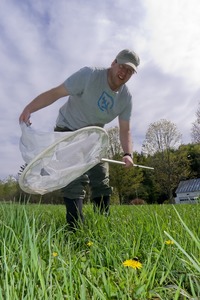Why does the survey need to collect bees?
There are over 300 species of bees known for Vermont and many of these are impossible to identify to species without a specimen. Some species even mimic each other. Most species of bees cannot be identified in the field with binoculars or by photographs because identification characteristics are microscopic. Identifying bees on the wing is very difficult as bees are constantly moving and seldom provide sufficient opportunity to view and identify them. Variable skill levels of observers also make confidence in identification and comparisons between observers or surveys impossible.Taxonomic experts need specimens to make identifications possible.The mortality caused by inventory and long term monitoring programs has not been shown to impact subsequent year bee populations. Gezon et al. (2015) found that the standardized method for sampling bees, with specimens from 132 morphospecies, did not affect bee communities in terms of abundance, rarefied richness, evenness, or functional group composition. Their results indicate that the bee communities were robust to such sampling efforts, despite removing an average of 2,862 bees per season. Mortality from collecting bees is generally compensatory, where collection deaths replace deaths that would have occurred naturally, and does not impact the population size/viability of bees in subsequent years.
What about Western Honey Bees?
Also known as the European Honey Bee (Apis mellifera), they were introduced to North America for agricultural use in the early 1600s and are now found on every continent except for Antarctica. We cultivate Western Honey Bees for agricultural use just like chickens or milk cows. In some ways, their prominence among the tens of thousands of pollinator species speaks to our use of them as ‘monocultures.’ And it is this human use that is the subject of new environmental concern. This survey will encounter many honey bees as they are out foraging and are counted, but we are focused on wild bees. Most Western Honey Bees are from managed hives or some feral hives. Managed bees (both honey and bumble bees) may transmit new diseases to wild bees, or they may allow existing diseases to multiply and “spill back” into wild populations. This is an area of active research.







